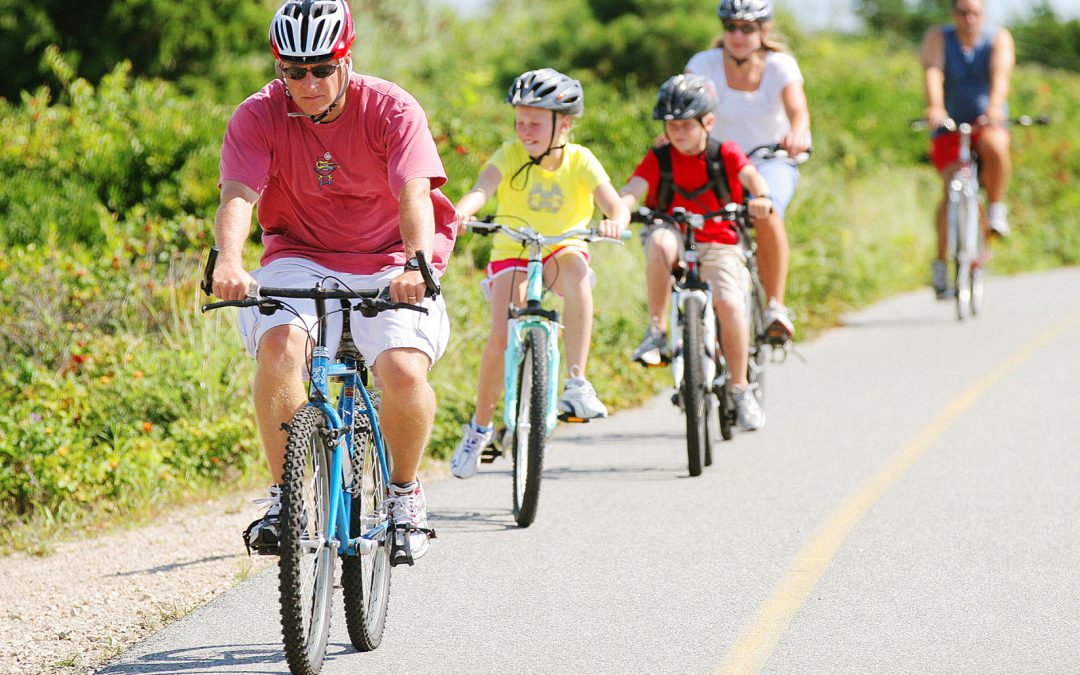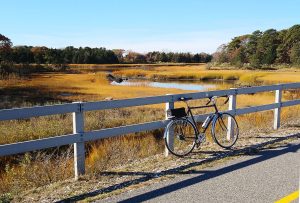
Views similar to this panorama, shot from the bicycle trail in West Falmouth, would be seen in spots along an expanded trail in Bourne.
By Deborah G. Scanlon
The Shining Sea Bikeway is undoubtedly one of Falmouth’s finest treasures. Thousands of residents and visitors enjoy it annually, grateful for its access to nature’s beauty and tranquility.
At the dedication of the bikeway extension in 2009, US Representative Joseph P. Kennedy III said he had often wondered what landscapes inspired Katharine Lee Bates’s poem, “America the Beautiful.”
“Just take a walk on this path and you’ll find out,” he said.
It took years of perseverance by determined Falmouth citizens to achieve their goal of converting the railroad into a bikeway.
The Old Colony Railroad and its successor, the New York, New Haven and Hartford Railroad, started running to Woods Hole in 1872, serving the Pacific Guano Company’s need for freight service for its fertilizer company on Long Neck (now Penzance), and later as transportation for summer residents and visitors. By the 1940s and ‘50s, however, the need for trains declined for a number of reasons, including competition from automobiles.
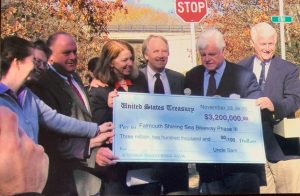 In 1960, Hurricane Donna washed out parts of the track near Oyster Pond. Rail service to Woods Hole resumed in 1961 but freight service ceased in 1963 and passenger service ended in 1964. The last train left Woods Hole with a work crew from the New Haven Railroad on March 12, 1965, as they took up the rails from the terminal in Woods Hole to Nobska Road.
In 1960, Hurricane Donna washed out parts of the track near Oyster Pond. Rail service to Woods Hole resumed in 1961 but freight service ceased in 1963 and passenger service ended in 1964. The last train left Woods Hole with a work crew from the New Haven Railroad on March 12, 1965, as they took up the rails from the terminal in Woods Hole to Nobska Road.
That year, when the railroad company petitioned the Department of Transportation for permission to abandon the Woods Hole run, the idea for the bike path came to a Woods Hole woman.
“That news caught the attention of Joan T. Kanwisher, an artist and mother of two daughters, with little previous involvement in civic affairs,” W. Redwood Wright wrote in a 2002 article in Woods Hole Historical Museum’s journal, Spritsail. “It was her idea that the abandoned right-of-way should be converted into a bicycle and bridle path, so early in 1965 she
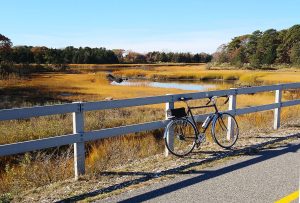
Views similar to this panorama, shot from the bicycle trail in West Falmouth, would be seen in spots along an expanded trail in Bourne.
wrote the railroad with her suggestion. To her astonishment, she very quickly got a response: the railroad was interested and a representative would call on her shortly to talk about it.”
She got in touch with her friend, Barbara Burwell, who lived on Fay Road near the railroad, and they met with the railroad representative, joined in later meetings by David Scott, who lived on Elm Road near the railroad tracks.
In December 1965 Ms. Kanwisher wrote to the Falmouth Conservation Commission with her idea, but nothing could be done until the railroad officially abandoned the right of way.
In 1968, the bankrupt New Haven Railroad petitioned the Interstate Commerce Commission for permission to abandon the segment of the right of way from Woods Hole to just beyond the Locust Street crossing. They wanted to sell the land and the rails, ties and ballast.
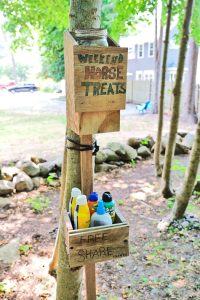
Free horse treats and sun protection sprays have been made available along the Shining Sea Bikeway near Palmer Avenue.
The Falmouth Conservation Commission recommended that the town acquire the land for conservation purposes.
In 1969, Penn Central, which had taken over the New Haven Railroad, began removing rails.
Selectmen called a special Town Meeting in April 1969 to consider taking the land by eminent domain for conservation purposes. It was approved, but then a day later the railroad announced that the whole parcel had been sold to Dr. Thomas Ballantine, a Boston surgeon whose family had a summer home in Woods Hole and wanted to preserve the area near their home on Little Harbor. Various negotiations and offers were unsuccessful, including the Ballantines’ offer to sell the town the way from Nobska Road to Falmouth, while keeping the Little Harbor section.
The Ballantines appealed the town’s taking of the land but the Barnstable Superior Court ruled in favor of the town in 1971, which was again appealed. After several more years to work out the terms of payment, the town was able to move forward with the bike path, four years after Town Meeting approved it.
Ms. Kanwisher worked with Nathan S. Ellis III, Falmouth Department of Public Works superintendent, on a plan to clear the brush on the bike path. The town provided $4,000 and the Woods Hole Oceanographic Institution and the Marine Biological Laboratory Associates each contributed $2,000.
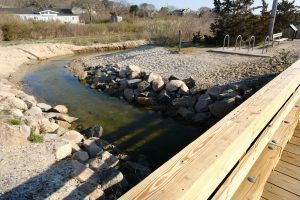
A herring run, Trunk River runs under the bridge at he Shining Sea Bike Way.
The DPW added crushed stone to the railbed and clay from the Gifford Street extension that was then in process, replaced the Trunk River culvert with a wooden bridge, and placed signs reminding motorists that cars were not allowed. Horseback riders were reminded to stay off the pavement.
Blacktopping, raising sections of the path along the beach, and rip rapping sections were all recommended by Mr. Ellis, and approved by Town Meeting.
By summer of 1974, the bike path was open. And that year, the governor signed a law that in the future, railroad property must first be offered to a public authority.
The bikeway was dedicated November 9, 1975.
The Falmouth Bikeways Committee held a contest for Falmouth school children to name the new bikeway. More than 250 entries were received, and the winner was Charlotte Hampton, who was in kindergarten at Mullen-Hall School, for her entry, Shining Sea Bikeway. She received a Schwinn bicycle as a prize, and helped cut the ribbon at the dedication.
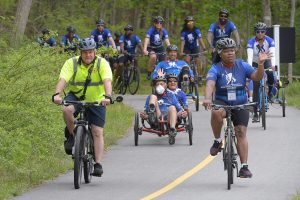
Wounded Warrior Ride along the Shining Sea Bikeway.
In 1975, the Superior Court issued a ruling on the amount the town should pay the Ballantines. It was eventually negotiated that the town pay $392,500.
Throughout this process, Ms. Kanwisher and Ms. Burwell were thinking ahead to a possible extension of the bike path. Ms. Kanwisher was a member of the town’s Conservation Commission, which introduced a resolution of intent that Town Meeting passed to acquire the seven miles of right of way from Falmouth to Bourne, should they become available.
The bike path extension happened in increments. The first was to extend the path, which initially ended at Locust Street, to Depot Avenue, then to Skating Lane then to Carlson Lane.
In 1999, Patricia Johnson submitted an article to Town Meeting asking selectmen to petition the state for the extension from Carlson to County Road in North Falmouth, up the center line. It passed, but Ms. Johnson said they had “a terrible time getting the state to have a path on the centerline: the state kept saying ‘we’re bringing the trains back.’ We needed to use the center line. In Sippewissett Marsh, for example, we couldn’t build the bike path on the side of the rail.”
Then Mitt Romney became governor, Ms. Johnson said, and with help from the governor and his staff, and State Rep. Eric Turkington and town officials including town engineer George Calise, the 99-year lease was approved for a bike path on the centerline.
In 2005, Sen. Edward M. Kennedy and Rep. William Delahunt came to town to present a check for $3.2 million in federal transportation funding. Leonard Johnson remembers that Sen. Kennedy started reading from his script, then put it aside and said, “Let me tell you why Cape Cod is the greatest place to live…”
In 2008 the upper track was removed and the following year, the bike path extension was finally completed from Falmouth center to North Falmouth, an additional 6.8 miles, making the total length from Woods Hole to North Falmouth 10.8 miles.
The dedication on a rainy summer day brought several hundred to celebrate with Rep. Kennedy, who read a letter from his uncle, unable to attend due to his poor health. Sen. Kennedy wrote, “Katharine Lee Bates might well have been describing your efforts in making this day possible.”
Cutting the ribbon that day were some of the people whose dedication made the bike path possible, including bikeways committee members Kevin Lynch, Edward Gross and Robert Fitzpatrick, retired town engineer George Calise, and Patricia Johnson, in addition to Rep. Kennedy, State Senate President Therese Murray, Rep. Turkington and Mary Pat Flynn, chair of the board of selectmen.
At the dedication, Ms. Flynn praised the work of Patricia and Leonard Johnson in securing money for the extension, and called Patricia Johnson “the mama of the bike path extension.”
In 2009, the Johnsons founded Friends of Falmouth Bikeways to enhance cycling in Falmouth. The group has funded the artwork along the bikeway; the building of Bud’s Stop near Depot Avenue honoring Joseph “Bud” Miskell, and construction of bikeway kiosks by the Lawrence School engineering class. The Friends also print informational brochures and the signs along the side of the bike path.
Ms. Johnson also petitioned the town to maintain the bike path, which comes up each year in the town budget.
As you enjoy the Shining Sea Bikeway, take time to thank the determined Falmouth citizens who have worked for years to bring the bikeway to fruition.
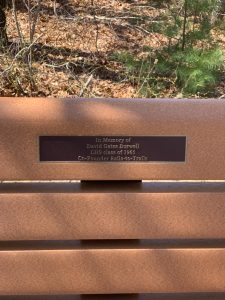 Rails To Trails
Rails To Trails
Rails to Trails was founded in 1986 to preserve unused rail corridors for public use. David Burwell, a lawyer with the National Wildlife Federation, was co-founder and first president. A Falmouth native, the son of Barbara and Langdon Burwell, he told the Enterprise in 1992 that “Falmouth is one of the leaders in the country in providing travel-related improvements. The Shining Sea Bikeway is being viewed on a national scale as a case study in ways to provide innovative solutions to transportation problems.”
At a conference of the National Rails to Trails Conservancy in 1987, he shared his personal feelings about the Shining Sea Bikeway. “When I visit my parents, I bike on it to get the morning mail at the post office. I jog on it to prepare for the local road race. I walk on it to meet neighbors and catch up on local events. And I watch the swans from the bridge over the old herring run, for the neighboring ponds have now become wildlife sanctuaries. In short, my local rail-trial, called the Shining Sea Bikeway in honor of Katharine Lee Bates, author of ‘America the Beautiful,’ keeps me in touch with my past and present. Along this trail I have a history.”
Mr. Burwell died in 2017. A bench in his memory is near the kiosk on County Road.

